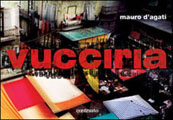“Vucciria” by Mauro d’Agati – Book Review
 Usually, when you pick up a coffee-table sized book of photographs taken in an Italian city, you know what you’re in for. You’ll get page after page of medieval cobbled streets, rolling hills with pine tree-lined driveways, romantic gondolas and roman-era monuments. You’ll be overwhelmed with color, history and – more than anything else – beauty. You might even find yourself getting bored with what seems like the same Tuscan vista in book after book. I mean, let’s face it – Italy’s beauty is boundless, but as with sugar, there really can be too much of a good thing.
Usually, when you pick up a coffee-table sized book of photographs taken in an Italian city, you know what you’re in for. You’ll get page after page of medieval cobbled streets, rolling hills with pine tree-lined driveways, romantic gondolas and roman-era monuments. You’ll be overwhelmed with color, history and – more than anything else – beauty. You might even find yourself getting bored with what seems like the same Tuscan vista in book after book. I mean, let’s face it – Italy’s beauty is boundless, but as with sugar, there really can be too much of a good thing.
Which is why Mauro d’Agati‘s book about the Palermo neighborhood of Vucciria is both a surprise and a delight. His photographs are colorful and historical, there is no doubt about it. But beautiful? Well, that’s a matter of some debate.
The old market neighborhood of Vucciria is, at best, run down. At worst, it’s an all-but abandoned and severely neglected district whose few remaining inhabitants are often unhappy about the drug dealers and criminals who live next door, high unemployment and slum conditions. Many people live in buildings that still show serious damage which was inflicted during World War II, and even further damaged by an earthquake in 2002.
Given all of that, it’s clear why people would be leaving, but d’Agati manages to capture not just the depression of the Vucciria neighborhood but also its colorful character in his photographs. Each oversized page is saturated with color – unreal color – and a grittiness that reflects the gritty life in the pictures. The inside covers of the front and back of the book are patchworks of faces, portraits d’Agati has taken in front of concrete walls or metal doorways. He said he didn’t want to take those pictures “next to their stands or in the piazza, or in their often anonymous houses, but in that sort of neutral setting which is an integral part of urban scene.” While most of the faces aren’t smiling, most of them also don’t appear sad.
And this is where we come to the debate about whether these pictures are, indeed, beautiful. Some certainly are, by any standards; they are nicely framed and capture moments we can all agree are sweet or, at least, nice to look at – the fishmonger fixing his customer’s tie, the kids hamming it up for the camera, the man giving his daughter a jovial hug. But others, while nicely framed and clearly telling a story, are difficult to look at – the heroin addict shooting up, the goat carcasses hanging in the butcher’s stand, the rooms abandoned after the earthquake (still with furniture in them and pictures on the walls). As a friend of mine casually flipped through my copy of “Vucciria” some months ago, I heard a sharp intake of breath just before she closed the book, only halfway through it.
“Vucciria” is probably not the coffee-table book about Italy that you’ll have out all the time, or flip through for fun when dreaming about your next trip to Italy. But d’Agati has captured a slice of real life in his book, and whether or not you ever visit Palermo, it’s still a good idea to know what’s there. Because something tells me the problems faced by the residents of Vucciria (and photographed so starkly and beautifully by d’Agati) are prevalent in much of Italy, even if it’s the Italy most tourists never see.
>> Buy “Vucciria” by Mauro d’Agati
Check out some of the other Italy-related books I’ve read and reviewed, too.
Full Disclosure & Whatnot: Just so y’know, the publisher sent me a copy of this book for review purposes.